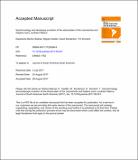Files in this item
Geochronology and landscape evolution of the strand-plain of the Usumacinta and Grijalva rivers, southern Mexico
Item metadata
| dc.contributor.author | Muñoz-Salinas, Esperanza | |
| dc.contributor.author | Castillo, Miguel | |
| dc.contributor.author | Sanderson, David | |
| dc.contributor.author | Kinnaird, Tim | |
| dc.date.accessioned | 2018-08-31T23:35:49Z | |
| dc.date.available | 2018-08-31T23:35:49Z | |
| dc.date.issued | 2017-11 | |
| dc.identifier | 251008867 | |
| dc.identifier | fab917fa-f6f4-4c55-8f98-abd36fa973e6 | |
| dc.identifier | 85033391690 | |
| dc.identifier | 000414619400027 | |
| dc.identifier.citation | Muñoz-Salinas , E , Castillo , M , Sanderson , D & Kinnaird , T 2017 , ' Geochronology and landscape evolution of the strand-plain of the Usumacinta and Grijalva rivers, southern Mexico ' , Journal of South American Earth Sciences , vol. 79 , pp. 394-400 . https://doi.org/10.1016/j.jsames.2017.08.021 | en |
| dc.identifier.issn | 0895-9811 | |
| dc.identifier.other | RIS: urn:C1D53832A374D9D8B654E3F2E14AEC49 | |
| dc.identifier.uri | https://hdl.handle.net/10023/15936 | |
| dc.description | Fieldwork and OSL laboratory analysis were funded by the project UNAM-PAPIIT (IA102615). | en |
| dc.description.abstract | The strand-plain of the Usumacinta and Grijalva rivers is the largest of the Gulf of Mexico as it is characterized by a sequence of well-preserved beach-dune ridges (n > 100) distributed ∼150 km along the shoreline. This prominent coastal landform is part of the delta plain of Tabasco and Campeche. We present geochronogical data of the beach-dune ridges sequence of the Usumacinta and Grijalva rivers. Radiocarbon dating failed in providing consistent ages of the ridges in contrast to optically stimulated luminescence (OSL), which yielded coherent and robust dates. The oldest beach-dune ridges were formed ∼2.5 ka. The presence of blocked-valley lakes evidences a recent process of sediment aggradation on the delta plain caused by a marine transgression. Using a regression model with the OSL ages and the distance of beach-dune ridges from the shoreline we estimate that the autoretreat yielded the sediment accumulation ∼7 ka. Our estimation agrees with other general models of sea level rising in the Gulf of Mexico that consider a marine stabilization initiated about ∼6–7 ka. The progradation rates of the beach-dune ridges (4.7–8.9 m yr−1) place this strand-plain among those with high sedimentation rates in the Gulf of Mexico and, perhaps, around the world. | |
| dc.format.extent | 2848650 | |
| dc.language.iso | eng | |
| dc.relation.ispartof | Journal of South American Earth Sciences | en |
| dc.subject | Strand-plain of Usumacinta and Grijalva rivers | en |
| dc.subject | Delta plain of Tabasco and Campeche | en |
| dc.subject | Landscape evolution | en |
| dc.subject | OSL | en |
| dc.subject | Gulf of Mexico | en |
| dc.subject | GE Environmental Sciences | en |
| dc.subject | NDAS | en |
| dc.subject.lcc | GE | en |
| dc.title | Geochronology and landscape evolution of the strand-plain of the Usumacinta and Grijalva rivers, southern Mexico | en |
| dc.type | Journal article | en |
| dc.contributor.institution | University of St Andrews. School of Earth & Environmental Sciences | en |
| dc.identifier.doi | 10.1016/j.jsames.2017.08.021 | |
| dc.description.status | Peer reviewed | en |
| dc.date.embargoedUntil | 2018-09-01 |
This item appears in the following Collection(s)
Items in the St Andrews Research Repository are protected by copyright, with all rights reserved, unless otherwise indicated.

